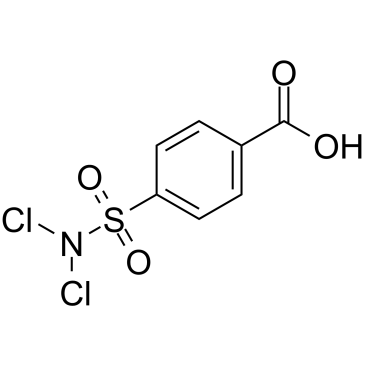Enzymes(酶)
Enzymes are very efficient and specific catalyst proteins which react with 1 or few types of substrates in biochemical reactions and are responsible for bringing about almost all of the chemical reactions in living organisms. Enzymes speed up reactions by providing an alternative reaction pathway of lower activation energy. Without enzymes, reactions take place at a rate far too slow for the pace of metabolism which means that they speed up the chemical reactions in living things.
There are 2 types of enzymes, ones that help join specific molecules together to form new molecules & others that help break specific molecules apart into separate molecules. Enzymes play many important roles ouside the cell as well. One of the best examples of this is the digestive system. For instance, it is enzymes in your digestive system that break food down in your digestive system break food down into small molecules that can be absorbed by the body. Some enzymes in your digestive system break down starch, some proteins and others break down fats. The enzymes used to digest our food are extra-cellular since they are located outside our cells & enzymes inside our cells are intra-cellular enzymes. Enzymes are used in ALL chemical reactions in living things; this includes respiration, photosynthesis, movement growth, getting rid of toxic chemicals in the liver and so on. Enzymes are proteins that must have the correct structure to be active. They are very easily affected by heat, pH and heavy metal ions.
Ribonucleoprotein enzyme catalytic activity is located in the protein part but for some the catalytic activity is in the RNA part. A catalyst is any substance which makes a chemical reaction go faster, without itself being changed. A catalyst can be used over and over again in a chemical reaction and does not get used up.
Enzymes lower the amount of activation energy needed by binding to the reactants of the reaction they catalyze, thus speed up the reaction and can process millions of molecules per second. Enzymes are typically large proteins with high molecular weight that permit reactions to go at conditions that the body can tolerate.
Enzyme nomenclature is based on what the enzyme reacts with & how it reacts along with the ending ase.
Enzymes must get over the activation energy hurdle.
Enzymes change how a reaction will proceed which reduces the activation energy and makes it faster. The more we increase the enzyme concentration the faster the reaction rate for non-catalyzed reactions. Enzymes that are catalyzed reactions also increase reaction rate at higher level of concentration but up to a certain point called Vmax which means that the enzyme has reached its maximum point. The reaction is limited by both the concentrations of the enzyme and substrate. Enzymes as catalysts take part in reactions which provide an alternative reaction pathway. Enzymes do not undergo permanent changes and remain unchanged at the end of the reaction. They only change the rate of reaction, not the position of the equilibrium.Enzymes as catalysts are highly selective by only catalysing specific reactions due to the shapes of the enzyme’s molecule.
Enzymes contain a globular protein part called apoenzyme and a non-protein part named cofactor or prosthetic group or metal-ion-activator. Changes in temperature and pH have great influence on the intra- and intermolecular bonds that hold the protein part in their secondary and tertiary structures.
Examples of cofactors are 1. Prosthetic group that are permanently bound to the enzyme. 2. Activator group which are cations (positively charged metal ions) & temporarily bind to the active site of the enzyme. 3.Coenzymes, usually vitamins or made from vitamins which are not permanently bound to the enzyme molecule, but combine with the enzyme-substrate complex temporarily. Enzymes require the presence cofactors before their catalytic activity can be exerted. This entire active complex is referred to as the holoenzyme.
Without enzymes, our guts would take weeks to digest our food, our muscles, nerves and bones would not work properly and so on…
Main Enzyme category groups:
Oxidoreductases:
All enzymes that catalyse oxido-reductions belong in this class. The substrate oxidized is regarded as a hydrogen or electron donor. The classification is based on 'donor:acceptor oxidoreductase'. The common name is 'dehydrogenase', wherever this is possible; as an alternative, 'acceptor reductase' can be used. 'Oxidase' is used only where O2 is an acceptor. Classification is difficult in some cases, because of the lack of specificity towards the acceptor.
Transferases:
Transferases are enzymes that transfer a group, for example, the methyl group or a glycosyl group, from one compound (generally regarded as donor) to another compound (generally regarded as acceptor). The classification is based on the scheme 'donor:acceptor grouptransferase'. The common names are normally formed as 'acceptor grouptransferase' or 'donor grouptransferase'. In many cases, the donor is a cofactor (coenzyme) that carries the group to be transferred. The aminotransferases constitute a special case.
Hydrolases:
These enzymes catalyse the hydrolysis of various bonds. Some of these enzymes pose problems because they have a very wide specificity, and it is not easy to decide if two preparations described by different authors are the same, or if they should be listed under different entries. While the systematic name always includes 'hydrolase', the common name is, in most cases, formed by the name of the substrate with the suffix -ase. It is understood that the name of the substrate with this suffix, and no other indicator, means a hydrolytic enzyme. It should be noted that peptidases have recommended names rather than common names.
Lyases:
Lyases are enzymes that cleave C-C, C-O, C-N and other bonds by means other than by hydrolysis or oxidation. They differ from other enzymes in that two (or more) substrates are involved in one reaction direction, but there is one compound fewer in the other direction. When acting on the single substrate, a molecule is eliminated and this generates either a new double bond or a new ring. The systematic name is formed according to 'substrate group-lyase'. In common names, expressions like decarboxylase, aldolase, etc. are used. 'Dehydratase' is used for those enzymes that eliminate water. In cases where the reverse reaction is the more important, or the only one to be demonstrated, 'synthase' may be used in the name.
Ligases:
Ligases are enzymes that catalyse the joining of two molecules with concomitant hydrolysis of the diphosphate bond in ATP or a similar triphosphate. 'Ligase' is often used for the common name, but, in a few cases, 'synthase' or 'carboxylase' is used. 'Synthetase' may be used in place of 'synthase' for enzymes in this class.
Products for Enzymes
- 41701(11)
- Activating Transcription Factor(3)
- Adenylate Kinase(10)
- AHCY(3)
- Aldolase(9)
- Asparaginase(5)
- Aurora Kinase(18)
- Beta Lactamase(3)
- Calcium and Integrin Binding(2)
- Calcium/Calmodulin-Dependent Protein Kinase(4)
- Carbonic Anhydrase(49)
- Casein Kinase(36)
- Cathepsin(52)
- Chitinase(5)
- Creatin Kinases(9)
- Cyclin(7)
- Cyclin-Dependent Kinase(18)
- Cyclophilin(23)
- Deaminase(14)
- Decarboxylase(12)
- Dehydrogenase(96)
- Discoidin Domain Receptor Tyrosine Kinase(2)
- DNA Polymerase(4)
- EGF Receptor(3)
- Endonuclease(6)
- Enolase(10)
- Enterokinase(5)
- Epimerase(3)
- Esterase(15)
- FGF Receptors(12)
- FK506 Binding Protein(10)
- Fructosamine 3 Kinase(2)
- Galactosidase(5)
- Glucosidase(32)
- Gluteradoxin(7)
- Glycogen synthase kinase(2)
- Glycosylase(10)
- Glyoxalase(3)
- Granzyme(7)
- Guanylate Kinase(2)
- Heparanase(2)
- Histone Deacetylase(3)
- Hydratase(10)
- Hydrolase(33)
- Hydroxylase(6)
- Isomerase(26)
- Jun N-terminal Kinase(1)
- Jun Proto-Oncogene(2)
- Kallikrein(26)
- Ligase(4)
- Lipase(14)
- Lipocalin(6)
- Lyase(9)
- LYVE1(3)
- Mitogen-Activated Protein Kinase(16)
- MMP(68)
- Mutase(11)
- Natural Enzymes(4)
- Nuclease(18)
- Nucleotidase(4)
- Nudix Type Motif(11)
- Other Enzymes(63)
- Oxidase(23)
- Oxygenase(12)
- Paraoxonase(3)
- Peptidase(41)
- Peroxiredoxin(10)
- Phosphatase(150)
- Phosphorylase(9)
- PI3-kinase(5)
- Polymerase(13)
- PPARG(2)
- Protease(15)
- Proteasome(54)
- Protein Kinase Akt1/PKB alpha(4)
- Protein Kinase-A(7)
- Protein Kinase-C(3)
- Protein Kinases(86)
- Protein Tyrosine Phosphatase(10)
- Reductase(60)
- Secreted Phospholipase A2(10)
- Serine Threonine Kinase(4)
- Sulfatase(8)
- Synthase(23)
- Synthetase(33)
- TGFBR(3)
- TGM2(3)
- TIMP(10)
- TPA(4)
- Transferase(156)
- Tyrosine Kinase(9)
- Ubiquitin Conjugating Enzyme(39)
- Uromodulin(4)
- VEGF Receptors(14)
- Transaminase(19)
- Hexokinase(6)
- TIE1(6)
- Cat.No. 产品名称 Information
-
GP26157
GST S. Japonicum
GST S

-
GP26156
GST S. Japonicum, His
GST S

-
GP21736
GST, 218 a.a.
Glutathione S-Transferase, 218 a.a. Recombinant

-
GP21735
GST, His
Glutathione S-Transferase Recombinant, His Tag

-
GP21737
GSTA1 Human
Glutathione S-Transferase Alpha-1 Human Recombinant

-
GP21738
GSTA1 Mouse
Glutathione S-Transferase Alpha 1 Mouse Recombinant

-
GP21739
GSTA4 Human
Glutathione S-Transferase Alpha 4 Human Recombinant

-
GP21740
GSTA4 Human, Active
Glutathione S-Transferase Alpha 4 Human Recombinant, Active

-
GP21741
GSTK1 Human
Glutathione S-Transferase Kappa 1 Human Recombinant

-
GP21742
GSTM1 Human
Glutathione S-Transferase M1 Human Recombinant

-
GP21743
GSTM1 Human, Sf9
Glutathione S-Transferase M1 Human Recombinant, Sf9

-
GP21744
GSTM1 Mouse
Glutathione S-Transferase M1 Mouse Recombinant

-
GP21745
GSTM1 Mouse, His
Glutathione S-Transferase M1 Mouse Recombinant, His Tag

-
GP21746
GSTM2 Human
Glutathione S-Transferase MU 2 Human Recombinant

-
GP21747
GSTM3 Human
Glutathione S-Transferase MU 3 Human Recombinant

-
GP21748
GSTM4 Human
Glutathione S-Transferase MU 4 Human Recombinant

-
GP21749
GSTM5 Human
Glutathione S-Transferase MU 5 Human Recombinant

-
GP21750
GSTM5 Human, Active
Glutathione S-Transferase MU 5 Human Recombinant, Active

-
GP21751
GSTO1 Human
Glutathione S-Transferase Omega 1 Human Recombinant

-
GP21752
GSTO1 Human Mutant
Glutathione S-Transferase Omega 1 Mutant Human Recombinant

-
GP21753
GSTO2 Human
Glutathione S-Transferase Omega 2 Human Recombinant

-
GP21754
GSTP1 Human
Glutathione S-Transferase pi 1 Human Recombinant

-
GP21755
GSTP1 Mouse
Glutathione S-Transferase pi 1 Mouse Recombinant

-
GP21756
GSTP2 Mouse
Glutathione S-Transferase pi 2 Mouse Recombinant

-
GP21757
GSTP2 Mouse, His
Glutathione S-Transferase pi 2 Mouse Recombinant, His Tag

-
GP21758
GSTT1 Human
Glutathione S-Transferase Theta-1 Human Recombinant

-
GP21759
GSTT2 Human
Glutathione S-Transferase Theta-2 Human Recombinant

-
GP21760
GSTZ1 Human
Glutathione Transferase Zeta 1 Human Recombinant

-
GC67938
Guaiacin
愈创木素
Guaiacin 是从 Machilus thunbergii SIEB. et ZUCC 的树皮中分离的芳基萘型木质素。Guaiacin 显着增加碱性磷酸酶活性和成骨细胞分化。
-
GP22526
GUK1 Human
Guanylate Kinase 1 Human Recombinant

-
GP22527
GUK1 Human, Active
Guanylate Kinase 1 Human Recombinant, Active

-
GP21761
GUSB Human
Glucuronidase Beta Human Recombinant

-
GC48421
GW 280264X
((S)-5-((2R,3S)-3-(N-羟基甲酰胺基)-2-异丁基六氨基)-2-氧代-6-(噻唑-2-基氨基)己基)氨基甲酸苄酯
An ADAM17/TACE and ADAM10 inhibitor
-
GP21762
GYG1 Human
Glycogenin-1 Human Recombinant

-
GP21763
GZMB Human
粒酶 B 人类重组体

-
GP21764
GZMB Human, sf9
Granzyme-B, Sf9 Human Recombinant

-
GP26158
GZMB Mouse
GZMB Mouse produced in Sf9 Baculovirus cells is a single, glycosylated polypeptide chain containing 235 amino acids (19-247 aa) and having a molecular mass of 26

-
GP21767
GZMH Human
Granzyme-H Human Recombinant

-
GP21768
GZMH Human, sf9
Granzyme-H Human Recombinant, sf9

-
GP21765
GZMK Human
Granzyme-K Human Recombinant

-
GP21766
GZMK Human, Sf9
Granzyme-K, Human Recombinant, sf9

-
GP21769
HAAO Human
3-羟基邻氨基苯甲酸 3,4-双加氧酶人类重组体

-
GP21770
HADH Human
Hydroxyacyl-Coenzyme A Dehydrogenase Human Recombinant

-
GP21771
HADHB Human
2-Enoyl-Coenzyme A (CoA) Hydratase, Beta Human Recombinant

-
GP21772
HAGH Human
Hydroxyacylglutathione Hydrolase Human Recombinant

-
GC39792
Halazone
哈拉宗
Halazone (Pantocide, p-sulfondichloramidobenzoic acid) is widely used to disinfect drinking water.
-
GP21773
HAO1 Human
Hydroxyacid Oxidase 1 Human Recombinant

-
GP21774
HAO1 Human, Active
Hydroxyacid Oxidase 1 Human Recombinant, Active

-
GP26159
HAO1 Mouse
HAO1 Mouse Recombinant produced in E

-
GP21775
HARS Human
Histidyl-tRNA Synthetase Human Recombinant





